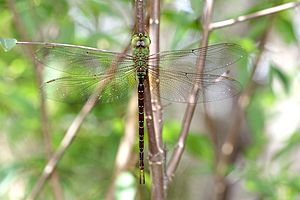Grey duskhawker facts for kids
Quick facts for kids Grey duskhawker |
|
|---|---|
 |
|
| Male, Queensland, Australia | |
| Conservation status | |
| Scientific classification | |
 |
The Gynacantha rosenbergi is a type of dragonfly often called the grey duskhawker. It belongs to the Aeshnidae family. This dragonfly likes to live near calm water, like swamps and ponds. You can find it in places like New Guinea, Indonesia, parts of northern Australia, and islands in the southern Pacific.
Contents
Meet the Grey Duskhawker
The grey duskhawker is a large dragonfly. Its wings can spread out to about 119 millimeters (about 4.7 inches). From head to tail, it's about 85 millimeters (about 3.3 inches) long.
This dragonfly has amazing colors! Its body, called the abdomen, is a dark rusty brown with bright greenish-yellow spots. The middle part of its body, called the thorax, is a light green. Its eyes are green with a touch of yellow. Like other dragonflies in the Aeshnidae family, its eyes are very big and meet at the top of its head. Right in front of its eyes, there's a dark mark on its face, called the frons. It looks like the letter 'T' if you look at it from above.
Body Shape and Features
The grey duskhawker's abdomen (tail part) is wider where it connects to its body. Then, it gets very thin, like a waist, at its third section. This "waist" is only about 2 millimeters wide. After this thin part, the abdomen slowly gets narrower towards the end.
Male dragonflies have small, ear-like bumps called auricles on the second section of their abdomen.
At the very tip of their tails, male Gynacantha dragonflies have two long, thin parts called anal appendages. These have tiny hairs on the inside. They use these parts to hold onto the female during mating. For the grey duskhawker, the tips of these parts curve slightly inwards and downwards. This special curve helps tell them apart from other dragonflies in their group.
Wings of the Duskhawker
The wings of the grey duskhawker are clear, like glass. Along the front edge of the wing, there's a small notch called the nodus, which is about halfway along the wing. Closer to the wing tip, there's a creamy patch about 5 millimeters long. This patch is called the pterostigma.
The base of the back wings often has a soft golden color. This golden color might even reach the nodus. Male dragonflies have a sharp, angled shape at the base of their back wings. Female dragonflies, however, have a rounded shape at the base of their back wings. Males also have a special triangle shape with three small sections on the inner edge of their back wings.
The front wing has a long, stretched-out triangle shape. The middle space of the wing is clear and doesn't have any extra lines or "cross veins."
How it Compares to Others
The grey duskhawker is bigger than another similar dragonfly called Gynacantha dobsoni. Even though they look quite alike, you can tell them apart by their size.
Where They Live
The grey duskhawker is not seen very often. It has been found in places like the Moluccas, Vanuatu, and New Caledonia. In Australia, people have seen it along the coast of north-east Queensland, starting from around Townsville. It has also been found on Moa Island in the Torres Strait and on Groote Eylandt in the Gulf of Carpentaria.
Duskhawker Habits
Grey duskhawkers like to live near still water, such as swamps and ponds. During the day, they rest in shady spots. They become active and fly around at dawn (sunrise) and dusk (sunset).
Images for kids







